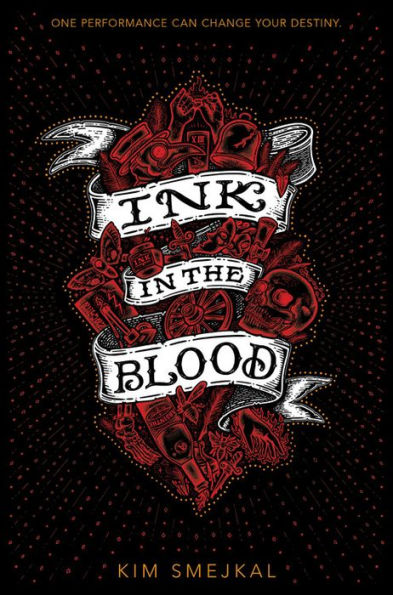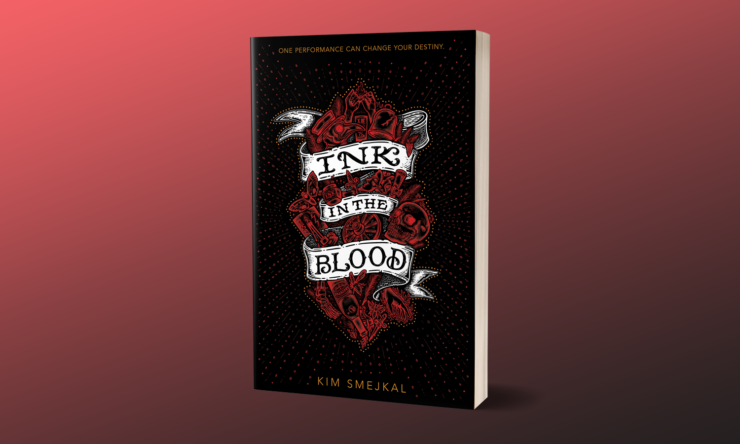One night, a tattoo appeared around Celia Sand’s ankle while she was sleeping. Awoken by a strange combination of magic and pain, Celia rushed to tell her mothers what had happened. The women were ecstatic, and told Celia the good news: it was finally time for her to serve the Divine.
Ink in the Blood, the debut novel by Vancouver-based author Kim Smejkal, follows Celia Sand and her best friend Anya Burtoni, who are devotees of the magical religion of Profeta. Followers of Profeta, or inklings, are able to use their magic to tattoo other devotees with symbols that represent the will of the Divine, Profeta’s mystical higher power, and all worship together at the beautiful Profeta temple. Being an inkling is considered one of the highest honors a worshipper of Profeta can achieve, and at first the girls are delighted to pursue this calling. But after ten years of servitude, the girls find out a harrowing truth: Profeta is built on lies, the tattoos strip followers of their freedom, and their beautiful temple is actually a torturous prison.
Smejkal’s debut is as masterful as it is unique. What perhaps stands out most in the novel is Smejkal’s incredible world building. From the very first page, the author envelops the reader in a dark, mystical world where the truth is always in question and mysteries seem never-ending. Smejkal’s language, both simple and otherworldly, also helps drive the tone of the book, placing the reader in a universe that is at once both strangely magical and eerily familiar.
Buy the Book


Ink in the Blood
Of course, the driving force behind the success of the story are it’s heartfelt characters and spellbinding plot. The dynamic between Celia and Anya feels very authentic, and their friendship effortlessly drives the novel forward, adding levity and elements of hope even during the story’s darker moments. The book’s plot itself is equally gripping, with surprising and moments occurring throughout the plot, which escalates quickly towards the end. The plot of the novel thickens when the two protagonists realize that Profeta is a fraud and begin to plan their escape. Their opportunity for freedom arrives with a traveling theater troupe called Rabble Mob that takes the two along with them and allows the girls to use their inkling abilities for theater rather than dark magic. For a while Celia and Anya are content—until they realize they are being followed. A chase between the two protagonists and the Divine then ensues, which is spooky and thrilling in equal measure, and Smejkal’s vibrant prose makes the reader feel like they too are escaping a demon from the past and running towards a vague yet enticing future.
The conflict between the Divine and Diavala, the mysterious evil force described in the book, is an interesting thread throughout the novel and one of Smejkal’s more nuanced points. From the opening pages, Smejkal sets up the Divine and Diavala as opposing forces through a fable that Celia is forced to recite to her mothers. The tale goes that a thousand years ago, a child was born who had magical powers and was able to speak to angels, and that child, who was Divine, quickly gained a massive following. Another child, Diavala, tried to claim that she too had magic powers, but followers of the Divine were not fooled by these lies and drowned Diavala for her treachery. Of course, later in the novel Celia discovers that this fable she was fed as a child was a lie, and really the Divine is a terrifying menace. Through this recurring conflict, Smejkal is able to cleverly juxtapose ideals of goodness versus evil as well as pose larger questions of religion and morality. Even as the novel opens, readers are given signs that Profeta is a hoax, despite the fact that followers worship something that they call “divine.” In the very first chapter, Celia calls Profeta a “crooked religion,” and notes that the statue of the Divine was “inhuman” and “sinister.” In this way, Smejkal uses Celia’s internal conflict to pose larger questions about what entities, religious or not, are actually holy or good.
One of the most enjoyable elements of the book was the incorporation of feminine magic. Gender plays a large role in Ink in the Blood. Almost all of the main characters—Celia, Anya, the mothers, Diavala, and Divine—are women, and through this Smejkal calls upon a tradition of magical femininity and witches. Celia’s mothers, characters who are introduced early on in the novel, were curious from the start; while their relationship is not outwardly romantic, the use of a communal maternal system to raise young girls reads as inherently queer. The strong bonds between the female characters are a huge driving force behind the novel, and an interesting background for a discussion on the creation of good and evil.
Ink in the Blood is a thrilling debut filled with heart, intrigue, and the perfect dose of magic. Smejkal uses the novel to pose big questions and ask us what happens when we are forced to come face to face to the demons we never knew we had.
Ink in the Blood is available from HMH Books for Young Readers.
Mary is a freelance writer covering culture, identity, sexual politics, and wellness. Her work has been featured in The Guardian, The Nation, Glamour, Teen Vogue, Bitch Media, Vice, Nylon, Allure, and other similar outlets. When she is not writing she can be found scheming, watching cartoons, or sending unnecessarily long emails. To see more of Mary’s work and adventures, follow her on Twitter.










